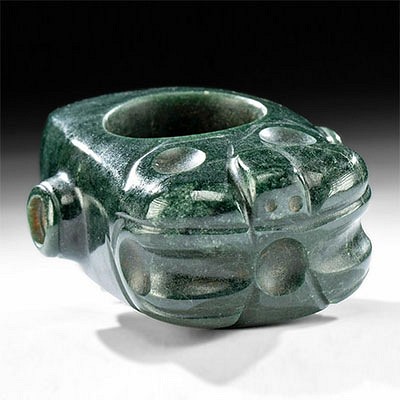Eastern Roman Lead Votive Applique - Horse and Rider
Lot 43
About Seller
Artemis Gallery
686 S Taylor Ave, Ste 106
Louisville, CO 80027
United States
Selling antiquities, ancient and ethnographic art online since 1993, Artemis Gallery specializes in Classical Antiquities (Egyptian, Greek, Roman, Near Eastern), Asian, Pre-Columbian, African / Tribal / Oceanographic art. Our extensive inventory includes pottery, stone, metal, wood, glass and textil...Read more
Categories
Estimate:
$900 - $1,200
Absentee vs Live bid
Two ways to bid:
- Leave a max absentee bid and the platform will bid on your behalf up to your maximum bid during the live auction.
- Bid live during the auction and your bids will be submitted real-time to the auctioneer.
Bid Increments
| Price | Bid Increment |
|---|---|
| $0 | $25 |
| $300 | $50 |
| $1,000 | $100 |
| $2,000 | $250 |
| $5,000 | $500 |
| $10,000 | $1,000 |
| $20,000 | $2,500 |
| $50,000 | $5,000 |
| $100,000 | $10,000 |
| $200,000 | $20,000 |
About Auction
By Artemis Gallery
Sep 10, 2020
Set Reminder
2020-09-10 10:00:00
2020-09-10 10:00:00
America/New_York
Bidsquare
Bidsquare : Antiquities | Asian | Ethnographic Art
https://www.bidsquare.com/auctions/artemis-gallery/antiquities-asian-ethnographic-art-5546
Featuring classical antiquities, ancient and ethnographic art from cultures encompassing the globe. Egyptian, Greek, Roman, Etruscan, Near Eastern, Asian, Pre-Columbian, Native American, African / Tribal, Oceanic, Spanish Colonial, Russian, Fossils, Fine Art, more! Artemis Gallery info@artemisgallery.com
Featuring classical antiquities, ancient and ethnographic art from cultures encompassing the globe. Egyptian, Greek, Roman, Etruscan, Near Eastern, Asian, Pre-Columbian, Native American, African / Tribal, Oceanic, Spanish Colonial, Russian, Fossils, Fine Art, more! Artemis Gallery info@artemisgallery.com
- Lot Description
Eastern Roman, Imperial Period, ca. 2nd to 3rd century CE. A votive applique or plaque comprised of lead (with some platinum and copper content as well) depicting a horse and rider, possibly an elite leader or gladiator, the rider depicted with a frontal pose so that we can see that he is wearing a fancy conical headdress and cuirass, both elaborately embellished with extensive cross-hatched motifs. The horse is delineated in profile and fitted with bridle and reins. Together they make a magnificent pair! Composition: 92.73% lead, 5.8% platinum, 1% copper. Size: 2.125" W x 3" H (5.4 cm x 7.6 cm).
In ancient Rome, equestrian sculptures were political works revering the emperor and his military and civic achievements, strategically placed in the empire to pay homage to his excellency. The likenesses of these statues were also copied on coins and other forms of visual culture - like this example - in order to widely disseminate imagery honoring specific emperors. Perhaps the rider on this piece depicts a revered leader. Indeed, the opulent costume of the rider certainly suggests an owner with elite status who is perhaps participating in a military parade.
Provenance: ex-Phoenicia Holyland Antiquities, ex-Mr. Khabbazi collected in November of 1992
All items legal to buy/sell under U.S. Statute covering cultural patrimony Code 2600, CHAPTER 14, and are guaranteed to be as described or your money back.
A Certificate of Authenticity will accompany all winning bids.
We ship worldwide and handle all shipping in-house for your convenience.
#157279Minor nicks to peripheries. Normal surface wear commensurate with age, but details are still quite strong. Surface deposits as shown.Condition
- Shipping Info
-
All shipping is handled in-house for your convenience. Your invoice from Artemis Gallery will include shipping calculation instructions. If in doubt, please inquire BEFORE bidding for estimated shipping costs for individual items.
-
- Buyer's Premium



 EUR
EUR CAD
CAD AUD
AUD GBP
GBP MXN
MXN HKD
HKD CNY
CNY MYR
MYR SEK
SEK SGD
SGD CHF
CHF THB
THB













